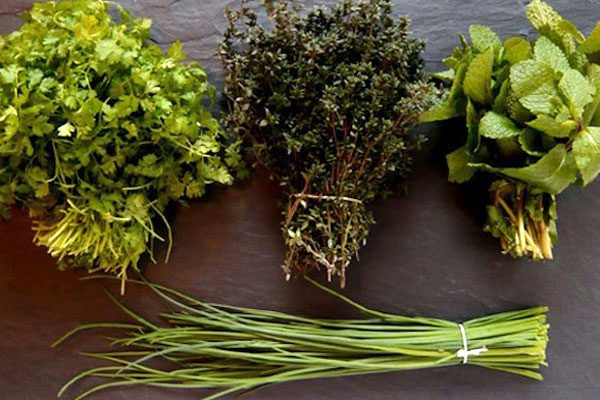
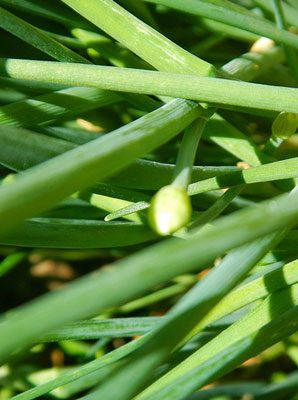
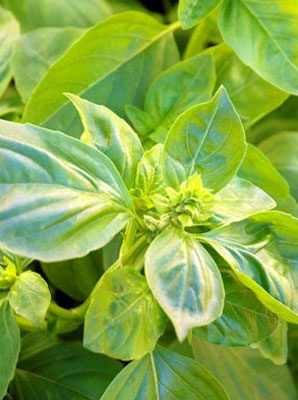
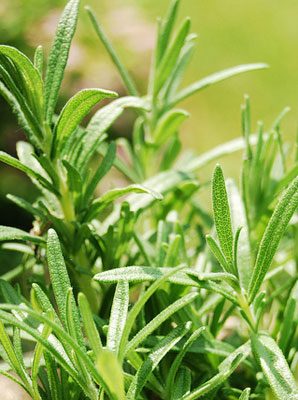
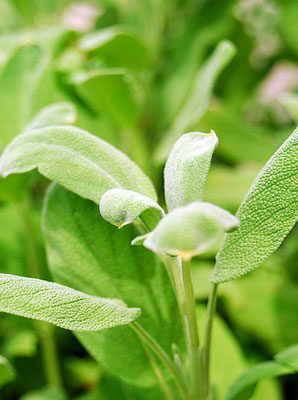
Basil: The varieties we find the most in the kitchen (like Genovese) have strong flavors of licorice and cloves, tasting somewhat like anise, with a pungent, often sweet smell. Basil is best raw or cooked only briefly. Use the leaves whole, tear them or chop them. The flower can be used in salad for decoration.
Chervil: Sometimes called garden chervil to distinguish it from similar plants also called chervil, or French parsley. Delicious in omelets, cream based or light sauces, salads, and with vegetables. Use it raw or at the end of cooking because it tastes very delicate. Visually, it looks like parsley but smaller, with lacy leaves and a flavor similar to anise-basil flavor. Don’t waste money on dried chervil as it totally lose its qualities.
Chives: Bright green, hollow, and looking like grass, with a mild onion flavor. Best raw or cooked only briefly in omelets, salads, soft cheese spreads and compound butter. As it freezes very well, you can buy large quantities for later use.
Oregano: Use it fresh or dried, cooked or as a garnish in small amounts. Oregano tastes great with tomatoes, cheeses, pizza, vegetables, beans, and vinaigrette sauces. This herb is a bit stronger and spicier than marjoram but sharing similarity. You can find fresh oregano at your local market from late spring to late fall. It will keep for up to 2 weeks in your refrigerator as long as leaves are dry.
Parsley: Used in everything from soups to salads, seafood, vegetables, eggs, vinaigrettes, sauces, and pasta. Its fresh flavor is appreciated in a lot of dishes. Flat-leaf parsley is preferred by some as it easier to cultivate, and has a stronger flavor, while curly leaf parsley is preferred by others because of its more decorative appearance in garnishing.
Rosemary: With crisp, piney aroma and flavor, rosemary is wonderful with beans and roast meats (especially lamb), also with vegetables, egg dishes, pasta, and breads. You simply can’t go wrong with rosemary! Use the woody branches to make skewers for grilling. You can buy fresh rosemary in supermarkets, dried leaves are also flavorful.
Sage: A powerful, slightly bitter, and very aromatic flavoring that pairs well with meat, game, fatty fish and poultry. Use fresh leaves whole or chopped with beans, stuffings, breads, biscuits, and pasta. Fresh leaves are best while dried one are stronger but with a duller taste. Use only one dried leaf in your flavorings. Good news is that you can grow it indoor easily for your culinary herb garden. Put in pots, close to a sunny window.
Tarragon: With dark green leaves, and strong, complex flavor and aroma, tarragon pairs well with chicken and seafood, sautéed okra, eggs, mushrooms and roasted onions. Use it in your cream-based sauces and reduction sauces. Infuse in vinegar by pouring warm vinegar over the herb and let stand covered for a week, give it a try! Whole or chopped fresh leaves can be cooked; but use it sparingly as the taste remains very strong. Fresh is always best while dried is less flavorful but usable as it lose most of its essential oils in the drying process.
Thyme: Minty, lemony, and earthy; this classic cooking herb is often used in long-simmering, braising or grilling recipes. It has a particular affinity to lamb, tomatoes and eggs. While flavorful, thyme does not overpower and blends well with other herbs and spices, provided you use it sparingly. Use it with olive oil and garlic at the beginning of sautés. Fresh is more pungent and aromatic than dried, but also less convenient; storage life is rarely more than a week. Dried thyme is very useful in every day cooking.
Dill: A rich fragrance similar to anise, oregano and cedar. Use dill in light sauces (sour cream, yogurt), delicate fish and salmon, salads, breads or paired with mustard. It’s better to use it at the end of cooking, as its flavor is diminished by the cooking process. Fresh is superior to dried, which has significantly less flavor. Dill seeds can be used as a spice to flavor soups and stews.
Mint: Chop or crush fresh leaves to release their flavor. Mint goes well with many vegetables and fruits like peas, potatoes or pineapples; perfect in yogurt-based sauces, chutneys, and North-African, Middle-East and Southeast Asian dishes in general. Mint is an ideal addition to herbal teas and cocktails. Mint is best fresh, though dried is sometimes a decent substitute but be careful to use it sparingly as its flavor can mask other ingredients. Its volatile oil oxidizes and vanishes quickly when exposed to heat so add it to your dishes at the last minute. Very easy to grow in pots.
(Photography: Alice Henneman)

